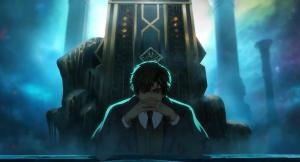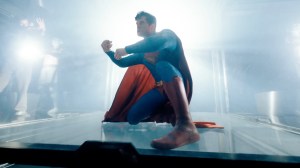
The special opens with several big names from film, television and comics talking about Marvel, starting off, appropriately, with Stan Lee.
Videos by ComicBook.com
“I think Marvel will be known as the company that has provided some of the greatest super characters for the public,” says Lee.
There are clips of Seth Green, Jimmy Kimmel, Brian Michael Bendis, and more talking about what Marvel means to them, until host Emily VanCamp officially introduces the special, promising to trace Marvel’s history from its roots as a small publisher, to its dominate presence in modern pop culture.
VanCamp introduces herself as Agent 13 from Captain America: The Winter Soldier, and shows viewers around Director Phil Coulson’s office, and appropriate place to recount Marvel’s history.
We are shown some scenes from The Avengers, and see many of the creative people who work on the Marvel Studios films, as well as several celebrities, talk about Marvel’s decision to start their own studio, and the immense amount of collaboration that went into creating those films and building towards the Avengers.
They move on to Guardians of the Galaxy, talking about how everyone thought it may have been Marvel’s first failure, but turned into a huge success. “This movie is a box of Cracker Jacks, but it’s all prizes,” says Patton Oswalt.
Jeph Loeb begins the discussion of how choosing to make their own movies transformed Marvel as a company, and how they have big plans going forward.
VanCamp goes back to 1939 in America, on the cusp of World War II. The story begins in New York City, where Marvel was founded as Timely Comics. At the time, they published anything but superheroes. Then Superman came about, the superhero craze began, and Marvel Comics #1 hit the stands featuring the Human Torch. Martin Goodman, the founder, was cousin-in-law to Stan Lee and hired Lee to the “comics department,” which was basically just Joe Simon and Jack Kirby.
Then the war came. Goodman wanted a patriotic hero. Simon and Kirby created Captain America. Jack Kirby and Joe Simons, being Jewish, began receiving death threats from the American Nazi Party. Simon, Kirby and Marvel published the famous cover with Captain America punching Hitler.
Following the war, Frederic Wertham publishes Seduction of the Innocent, the Comic Code Authority is born, and comics lose their symbolic edge. The comics industry suffered greatly, and television only made matters worse. Lee recounts how he only wrote what Goodman wanted, and what Goodman wanted was whatever the fad of the moment was. Denny O’Neil notes how the original generation of comic book artists were ashamed of what they created, even Stan Lee changed his name from Stan Lieber so not to sully it.
VanCamp begins the story of how Lee, Kirby, and Steve Ditko helped save the industry. Lee, frustrated and ready to leave the industry, took his wife’s advice and decided to do a book how he’d like to do it for a change. He and Kirby went on to create the Fantastic Four, and the modern Marvel Universe was born.
The next creation was the Hulk, which tried to make the monsters that were so popular in comic books at the time into something heroic. Then came the idea to create something different, a teenage hero. And so Lee and Ditko came up with Spider-Man. Marvel was on fire, creating Ant-Man, Thor, Iron Man, Doctor Strange, Nick Fury, the Avengers, and the X-Men all in the same month. It’s an incredible output for three creators. The Marvel Age of Comics was born.
As the counter culture began to gain steam, the Comics Code Authority became less desirable or necessary. Lee convinced Goodman to ditch the CCA seal. Marvel begins to diversify their lineup, with Black Panther seeing his own series, several female heroes being created, and the X-Men standing in for minorities.
VanCamp recounts that, after 30 years, Goodman was read to retire and handed the reigns over to Lee. Lee appointed Jim Shooter as editor-and-chief as they entered the 1980s. They hired lots of new talent and expanded the line. New characters like Punisher, Iron Fist, Wolverine, and Thanos were born. The direct market is born, and comic conventions begin.
Marvel began trying to get a foothold in Hollywood. There were several abandoned projects, animated series, and television shows. Lee and Shooter note that the effects just couldn’t keep up with their characters, but the Hulk managed to be a success on television.
In the 1980s, the anti-hero began to emerge, led by creators like Frank Miller, John Byrne, and Chris Claremont. Artists like Jim Lee, Todd McFarlane, and Rob Liefeld began working at Marvel. The books got dark to the point of controversy, but the books sold better than ever. The artist became the rock star, as Kevin Smith notes, and Marvel surpasses D.C. for the first time…just before going bankrupt.
The creators recount how bad things got at the time. Something went wrong on the business end. People were laid off, and the Marvel characters were in danger of being sold off and separated. In 2000, Joe Quesada was hired on as editor-and-chief, bringing his “eternal optimism” with him. He felt that all they had to do was go back to the days of Stan, Jack and Steve. Allow creative freedom, and tell stories that reflect the real world.
Marvel reinvented itself and began to see itself as more than a comic book company. They began by optioning off their characters to other studios. Alan Fine began attending the Marvel retreats where they would plan out stories for the next year, and Fine believed they should take that strategy a step further. They bet their movie studios dreams on Iron Man, then a B-list character.
Iron Man ended up being hugely successful and profitable. From there, they Marvel Cinematic universe was born. This success led Disney to buy the company, and the two companies complement each oehter so well. They talk about the future, show the cover to secret war, and behind-the-scenes footage from Ant-Man, and Avengers: Age of Ultron. Jeph Loeb discusses the street-level Defenders coming to Netflix, the animated series, Agents of S.H.I.E.L.D. and Agent Carter.
VanCamp introduces new footage from Agent Carter.
Carter is talking to Howard Stark, who seems to be leaving town and heading overseas to track some of his work that has been stolen and sold. He needs Carter to track down the ones that got sold domestically. Someone got ahold of a formula he came up with that creates a molecular nitroamine powerful enough to be hugely destructive in even small doses. Stark introduces her to his butler, Edwin Jarvis. He takes off on his boat. Carter tells Jarvis to make sure he introduces himself when he approaches a woman in a dark alley. Carter “goes to work,” beating up someone and throwing him out a window.
VanCamp signs off.









